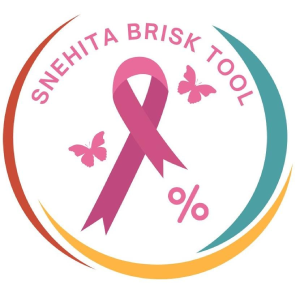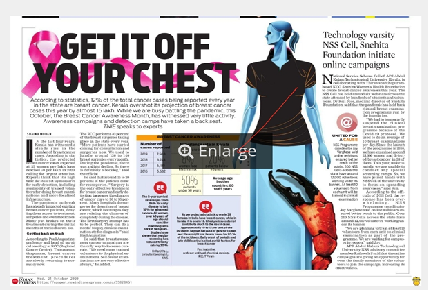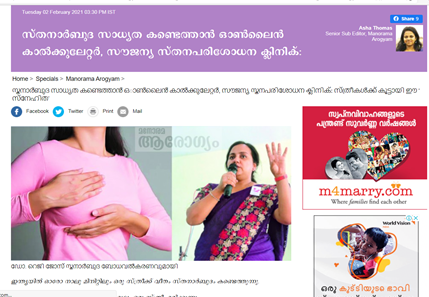 SNEHITA BREAST CANCER RISK CALCULATOR
SNEHITA BREAST CANCER RISK CALCULATOR
Understand Your Risk, Stay Safe
Snehita Breast Cancer Risk Calculator, based on the Snehita BRISK model, is an easy, science-backed tool that estimates your lifetime risk of breast cancer. Designed especially for women in India, it helps you and your doctor decide the best screening plan for you.
How It Works
The calculator looks at seven simple factors about your life to create a personalized risk score. These factors come from a study of 1,570 Indian women (660 with breast cancer, 910 without). This was later validated in a cohort of 8483 women.Here’s what we ask:
- Your Age: Risk goes up as you get older.
- Age at First Period: Starting your periods early can increase risk due to longer hormone exposure.
- Age at First Childbirth: Having your first child after 30 or not having children can raise risk; earlier childbirth may lower it.
- Irregular Periods: Irregular cycles might mean hormonal changes that slightly increase risk.
- Breastfeeding History: Breastfeeding for 24 months or more (total across all pregnancies) can lower your risk.
- Family History: If your mother, sister, or daughter had breast cancer, your risk is higher.
- Past Breast Biopsies: Previous biopsies, especially if they found abnormal cells, increase risk and may point to dense breasts or benign conditions that need closer monitoring.
The calculator uses these answers in a scientific formula (built and tested for Indian women) to give you a risk score, showing your chance of developing breast cancer in your lifetime.
What Your Risk Score Means
After entering your details, you’ll get a score that places you in one of four risk categories:
| Risk Level | Score Range | What It Means | What to Do |
|---|---|---|---|
| Normal Risk | Below 0.4004 | Your risk is lower than most women (below the 50th percentile). | Keep up with routine checkups, like yearly breast exams by a doctor from 30 years of age. |
| Moderate Risk | 0.4004 to 0.574 | Your risk is average or slightly higher (50th to 75th percentile). | Consider breast exams every 6 months from 30 years of age and talk to your doctor about prevention. |
| High Risk | 0.574 to 0.795 | Your risk is higher (75th to 95th percentile). | Get breast exams every 4-6 months from 25 years of age and possibly imaging (like mammograms) as advised by your doctor. |
| Very High Risk | 0.795 and above | Your risk is very high (top 5% of women). | Be extra vigilant with breast exams every 4 months from atleast 25 years of age and more frequent imaging as per your doctor’s advice. |
The calculator also uses age-specific cut-offs (0.35 for women under 50, 0.41 for those 50 and older) to guide screening intensity. A higher score means you need closer monitoring to catch any issues early, when they’re easier to treat.
Why It’s Special
Unlike Western tools (like the Gail Model), the Snehita BRISK model is made for Indian women. Breast cancer in India often affects younger women and is influenced by our unique lifestyles. Our research found:
- The calculator is accurate, with a score of 0.699 (out of 1) overall, working better for women over 50 (0.750) than under 50 (0.673).
- Major risk factors for Indian women include not having children or having your first child after 30 (2.8 times higher risk), past biopsies (4.1 times higher risk), family history (2.2 times higher risk), and irregular periods (1.6 times higher risk).
- Breastfeeding for 24 months or more lowers risk significantly (0.4 times the risk), a common practice in India.
This makes our calculator more accurate and helpful for Indian women compared to other tools.
How to Use It
- Answer a Few Questions: Share your age, period history, childbirth details, and family history. It takes just a few minutes!
- See Your Score: Get your risk score and a simple explanation right away.
- Talk to Your Doctor: Share your score with your doctor to plan the best next steps. This tool guides you, but it’s not a diagnosis.
It works best for women aged 30 and above, but younger women can use it to start a health conversation.
Things to Keep in Mind
This tool is helpful but not perfect. It doesn’t yet include factors like genetics (e.g., BRCA mutations), environmental exposures, or breast density. We’re working to improve it! Also, it was tested in Kerala, so we’re doing more studies across India to make it even better. Always check with your doctor for medical advice.
Guidance for Early Detection
All women are encouraged to have breast self-awareness from 18 years of Age , Clinical Breast Examination by an expert from 30 years of Age Every year, Radiological breast examinations(RBE) (Sono mammogram, Xray Mammogram or MR Mammogram) as per the health care provider's guidance after risk assessment and clinical breast examination. The general recommendation is to have a baseline Mammogram at the age of 50 years along with yearly Clinical Examinations.
Take Action Now
Ready to check your risk? Use the Snehita Breast Cancer Risk Calculator—it’s free, quick, and private. After getting your score, join our awareness sessions or talk to a Snehita volunteer for support. Let’s work together to make early detection possible for every woman in India!
Learn More: Research Behind the Tool
Want to dive deeper? Check out these studies:
1. Jose, R., et al. (2025). Development and validation of the Snehita BRISK model: A breast cancer risk assessment tool for risk stratification in women of the Indian subcontinent. Clin. Epidemiol. Glob. Health. Read here
2. John, S., et al. (2023). Breast Cancer Risk Stratification and Screening Practices of Women in South Kerala, India. J. Clin. Diagn. Res.
3. Jones, M., et al. (2023). Cancer screening behaviours and preferences among women in southern India. J. Cancer Policy. Read here
4. John, S., et al. (2018). Prevalence of Known Risk Factors of Breast Cancer and Breast Cancer Screening Practices Among Women in Thiruvananthapuram, Kerala, India. J. Glob. Oncol.
5. Jose, R. (2015). Breast Cancer Awareness and Screening: A New Approach. Acad. Med. J. India.
6. Jose, R., et al. (2017). Breast Cancer Risk and Screening practices among Health care workers in a tertiary care centre, Trivandrum, South India.
7. 7. Augustine, P., et al. (2014). Risk Factors of Breast Cancer in Kerala, India - A Case Control Study. Acad. Med. J. India.
8. Jose, R., et al. (2018). Clinical Breast Examination Campaign: Experience From Thiruvananthapuram, South India. J. Glob. Oncol. Read here
9. Augustine, P., et al. (2015). Usefulness of Gail Model Breast Cancer Risk Assessment Tool in Estimating the Risk for Development of Breast Cancer in Women of Kerala India. Acad. Med. J. India.
Blog:: The Story of the Snehita Brisk Tool
SNEHITA BREAST CANCER RISK CALCULATOR
SNEHITA IN NEWS
The New Indian Express
21st October 2020

The New Indian Express
20th October 2020
The News Minute
23rd October 2020
Deshabhimani
30th October 2020

Vanitha






